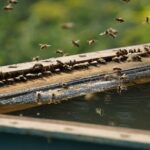Did you know that termites, those tiny insects that often go unnoticed, possess remarkable capabilities that are truly awe-inspiring? As an experienced entomologist with a deep fascination for these creatures, I have spent years delving into the intricacies of their behaviors, architectural wonders, and ecological importance. Now, I intend to share with you the astonishing and often overlooked abilities of termites, from their unparalleled nest-building skills to their vital role in nutrient cycling. Prepare to be amazed as we embark on a journey into the world of these remarkable insects and uncover their extraordinary capabilities.

Remarkable Termite Capabilities
Termites may be small insects, but they possess extraordinary capabilities that continue to astound scientists and researchers. These remarkable creatures exhibit a wide range of behaviors and skills that contribute to their ecological significance and architectural marvels. In this article, we will delve into the awe-inspiring world of termites and unravel their incredible abilities that set them apart from other insects in the animal kingdom.
Architects of Elaborate Nests
One of the most remarkable termite capabilities lies in their unparalleled ability to construct complex nests. These structures, often towering above the ground, serve as a hub for their colonies and provide protection from predators and environmental changes. But what makes their nests truly extraordinary is the intricate network of tunnels and chambers within. It’s as if termites have mastered the art of architectural engineering, creating a sophisticated maze that ensures the survival and prosperity of their entire community.
“Termite nests are architectural wonders, a testament to their remarkable skills in creating intricate and functional habitats for their colonies.”
Regulating Environments with Precision
Termites are not just skilled builders; they are also expert environmental regulators. Within their nests, termites maintain a stable microclimate, carefully managing temperature, humidity, and gas composition. This precise control allows them to create optimal conditions for their activities and the well-being of their colony. Imagine having the ability to adjust the internal environment of your home to perfection, without any technological aids. Termites accomplish this feat naturally, showcasing their remarkable capabilities as true master regulators.
“Termites are nature’s architects and environmental regulators, fine-tuning their nests with unparalleled precision to create a haven for their thriving communities.”
Crucial Contributors to Ecosystem Functioning
While termites may sometimes be associated with the damage they cause to homes and structures, it is essential to recognize their significant role in ecosystem functioning. Termites play a vital part in the complex web of nutrient cycling. By breaking down plant material and organic matter, they facilitate the decomposition process and the recycling of nutrients back into the soil. This contribution ensures the sustainability of ecosystems and supports the growth of diverse plant life.
“Termites, often underestimated and misunderstood, play a critical role in maintaining the balance of ecosystems, actively participating in the recycling of nutrients and promoting the health of our natural world.”
Inspirations for Biotechnology and Swarm Cognition
Beyond their ecological importance, termites have also captured the attention of scientists and researchers in fields such as biotechnology and swarm cognition. The collective behavior and efficiency of termite colonies have inspired novel approaches to engineering and problem-solving. Researchers study termite swarm intelligence to find insights into optimizing systems and processes, as well as applying these principles to various real-world scenarios. Termites, with their remarkable abilities, continue to inspire groundbreaking innovations.
“Termites, through their collective intelligence, serve as nature’s pioneers, inspiring researchers and scientists to explore new frontiers in fields like biotechnology and swarm cognition.”
Unveiling Nature’s Resilient Innovators
In conclusion, termites are not just pests or nuisances; they are nature’s resilient innovators. Their remarkable termite capabilities, from their architectural prowess to their environmental regulation skills, demonstrate their adaptability and unique contributions to the natural world. By acknowledging and understanding these incredible insects, we can gain a deeper appreciation for the wonders of nature and the intricate connections that sustain life on our planet.
“The world of termites, a microcosm of ingenuity and resilience, invites us to marvel at the creativity and adaptability found in even the tiniest of organisms.”
Here is an example of an active internal link using Hugo syntax:
“Did you know that termites are fascinating creatures? They have intricate social structures and are responsible for massive amounts of damage to homes and buildings. If you’re curious to learn more, check out our informative Termite Fact Sheet!”

FAQ
Q: Do termites pose a threat to humans?
A: Termites do not bite or attack humans. However, they can cause significant damage to homes, including foundation problems, cracked walls, and inadequate closing doors and windows. Repairing termite damage can be expensive.
Q: How can termite infestation be treated?
A: Termite treatment is an important part of pest control and includes options such as baiting, spot treatments, fumigation, and physical removal. These methods help eliminate termites and prevent further damage to structures.
Q: What are some remarkable capabilities of termites?
A: Termites have a weak biting ability and are not a serious problem for humans. However, their abilities lie in their incredible architectural skills. They can construct complex nests and regulate environments. They also have mutualistic associations with certain fungi and emit hydrogen gas, which plays a role in controlling microbial composition.
Q: How do termites contribute to ecosystems?
A: Termites control microbial composition and biogeochemical cycling in their mounds. They play a vital role in nutrient cycling and decomposition processes, helping to maintain the balance of ecosystems.
Q: Are there any practical applications of studying termites?
A: Yes, termites have been studied as models for biotechnology and swarm cognition. Their unique behaviors and capabilities have inspired innovative solutions in fields such as robotics and optimization algorithms. For example, the termite life cycle optimization algorithm is a bio-inspired meta-heuristic approach to optimization problems.
- Crypto Quotes’ Red Flags: Avoid Costly Mistakes - June 30, 2025
- Unlock Inspirational Crypto Quotes: Future Predictions - June 30, 2025
- Famous Bitcoin Quotes: A Deep Dive into Crypto’s History - June 30, 2025
















